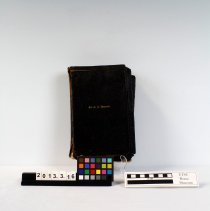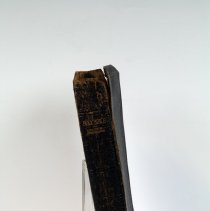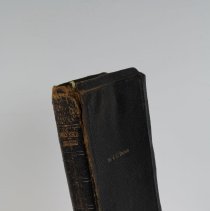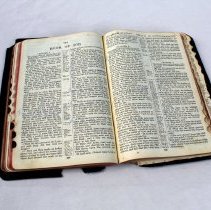Object Record
Images





Metadata
Catalog Number |
2013.003.016 |
Object Name |
Book |
Description |
This leatherbound Bible features the text "Dr. C.C. Sherrod" inscribed on the cover in gold lettering. "C.C. Sherrod" is written on the front page in purple ink. "From The S.C. William Bible Class Dec. 25, 1926." is written underneath in blue ink. There is a bookmark on a page with a map of the Mediterranean Sea. The bookmark features a picture of a blonde, blue-eyed boy with a doll and the quote "He who dries her brother's tears, Will never weep alone. He who calms his brother's fears Need never be afraid. Your one gift works many wonders." A Reece Museum volunteer produced a biography of President Charles Chester Sherrod, Sr., which is copied below. The researcher's sources can be provided upon request. "Charles Chester Sherrod, Sr. 1882-1967 Charles C. Sherrod, the son of Isaac Sherrod the fourth and Elizabeth Sherrod, was born in Knox County, Tennessee on September 13, 1882. His family settled in Knox County around 1816. Sherrod was raised in the Strawberry Plains area of East Knox County. He married Carrie Lee Hood on August 28, 1910. They had four children: Isa Lee Freeman, Wilma Dean (or Deen) Platt, Charles, Jr., and Howell. Sherrod received his elementary and secondary education in Knox County and spent several years attending college: -Maryville College, Blount County, Tennessee 1902-1903 -Tennessee Normal School, Fountain City, Knox County, Tennessee 1902-1905 (A.B.) -Valparaiso College, Indiana, 1909 (L.L. B.) -George Peabody College for Teachers (Vanderbilt), Nashville, Tennessee 1921 (M.A.), 1924 (Ph.D.) -Fellowship Student, George Peabody College for Teachers, Director and Professor of the Demonstration School; 1924-1925 In 1950, an honorary L.L.D. was conferred upon Sherrod by Emory and Henry College, Virginia. The Johnson City Chronicle, on January 15, 1928, announced that Sherrod was a candidate for Peabody Trustee. The article listed the following positions Sherrod had held over the years: -Teacher and Principal public schools, Knoxville, Tennessee -Superintendent of Schools, Millington, Tennessee -Superintendent of Schools, Madisonville, Tennessee -Instructor of History and Civics, Knoxville High School -East Tennessee State Normal School, Johnson City, Tennessee (Summers 1918, 1920) -Superintendent of Schools, Morristown, Tennessee -Professor of Education and Director of Demonstration School, Peabody College, Nashville, Tennessee Omitted from that list was his time spent in Kansas where he was a grade school teacher, high school teacher and superintendent in Lake City and Medicine Lodge. He ran for county superintendent on the Progressive ticket. In a letter published in the local newspaper, he touted his experience in every education field in the state. He told voters he had spent seven years in colleges and universities at a cost of over $4,000, noting that he had worked his way through school doing odd jobs including washing dishes, firing furnaces, mopping floors, waiting tables, barbering, pressing clothes, teaching school, etc. He said he owed only $350 when he finished school. Despite his qualifications and an open appeal to voters, he lost that election by 11 votes. SHERROD COMES TO JOHNSON CITY, TENNESSEE In June 1924, the State Board of Education elected Sherrod to the position of President of East Tennessee State Normal School at Johnson City. Sherrod refused to serve at the salary offered; $4,200 per year. Therefore, the Board reelected the current president, Sidney G. Gilbreath. A year later Sherrod again was elected President of East Tennessee Normal School by the State Board of Education. He accepted the position on June 19, 1925. He was the second President of the school and assumed his new duties on September 1, 1925, with a formal inauguration on February 18, 1926. In 1949 Sherrod resigned his position citing long hours and constant pressure of duties exacting a heavy toll on his energy. Upon that resignation, he was appointed to serve as President Emeritus at one-half his president's salary with duties to be assigned by his successor. During his 24 year tenure he had prepared a plan of organization and administration for the Master's Degree program and also taught some courses required for that degree. Sherrod published the first student handbook, and organized the first Homecoming in fall of 1925. By the end of the 1920s he had overseen the construction of the first teacher's training school. The building is now University High School. The Great Depression was hard on the university. The state considered closing what was now called Tennessee State Teachers College saying it was an "unnecessary" luxury, but that was defeated in 1936. At least for one year, Sherrod took no salary as a way help the struggling school. Sherrod noted that he received food from the school gardens and that would help him forego his salary. Hard times didn't deter Sherrod. In 1931 a new "fireproof" library opened with one floor designated as a museum. A Johnson City Press article dated August 22, 1968, reported on an open house for the library saying it was already acclaimed as one of the finest functional libraries in the nation with seating for 2,000 students and shelving for 400,000 volumes. Sherrod personally helped design the library and watched it grow from 4,123 volumes to over 41,000 volumes. A main feature was the Reading Room on the first floor. In September 1949, after an authorization by the Tennessee Legislature and a unanimous vote of the faculty, the library was named the C.C. Sherrod Library. Also in 1931, a civilian pilot training program was offered on campus. Later, in the 1930's Workers Progress Administration workers built an outdoor football stadium and amphitheater. The school's open air amphitheater was dedicated by Sherrod. There was no expense to the college for this theater. It was built by WPA labor, with materials from the college grounds. The amphitheater is still a campus highlight today, known for its orchestra pit surrounded by evergreen trees. In 1934, Sherrod was recommended by Trustees to become President of the University of Tennessee in Knoxville. The Trustees noted his ability, foresightedness and proven success. Whether Sherrod would have accepted the position is unclear, but apparently their current president remained at UT and a change wasn't necessary. In 1943, the school's name changed to East Tennessee State College. Numbers of male students were shrinking and in 1943 Sherrod initiated the college's first military training program; Army Air Corps Cadets. Also in 1943, a nursing program was added to the curriculum as well as a program for assistant health workers. The school experienced exceptional growth during those World War II years, helped by veterans taking advantage of the GI Bill. During his tenure, buildings added to the campus were the training school, library, science building, heating plant, shops, a classroom building, Cooper Hall, Cooper Cottage, Lake Street Cottage, Home Management House, Wheeler House, the stadium, Lyle House and the equipment building. Additionally, at the time of his resignation, nearly $1 million had been authorized for new buildings. The campus area had increased from 120 to 176 acres. He oversaw the accreditation by Southern Association of Colleges, the American Association of Teachers Colleges and the Teachers College Extension Association, none of which recognized the school when he came on board in 1925. Also, during his tenure, the value of the school campus grew from $700,000 to $2.5 million. Known as a forceful speaker, Sherrod spoke countless times at various occasions. He was known as a most aggressive educator and one with uncommon ability. A Johnson City Press article written in 1967 upon his death at age 84 described Dr. Sherrod as eminently successful, "a go-getter, a driver, a pusher, and a booster." The article said Sherrod was a giver and had devoted himself unselfishly to the public good. He was only away from his post two weeks due to illness and had taken only 17 weeks in annual leaves during his 24 year tenure. For many years Sherrod served, at times, as an inspector of colleges applying for accreditation. He had served in various positions in numerous organizations and associations including the Tennessee State Board of Education; President of East Tennessee Education Association; President of Tennessee College Association and Member of Tennessee Educational Commission. He was a chairman of the Board of trustees of three Methodist/Holston Conference Colleges: Hiwassee, and Tennessee Wesleyan in Tennessee and Emory and Henry in Virginia. He was a member of the Board of Directors of the Chamber of Commerce, Peoples Bank, and was Vice President of the Board of Directors of First Federal Savings and Loan, and he had served as a member of the state board of education, and the East Tennessee Educational Association, just to name a few. His involvement in every phase of education was extensive. He was a Rotarian and author of "Administrative Practices in Tennessee High Schools," as well as numerous other educational articles. He was a Sunday school teacher for more than 40 years." |
Date |
1926 |
Collection |
ETSU Memorabilia |
Place of Origin |
Europe/England/London |
Material |
India paper, ink |
Subjects |
local history |
Made |
Oxford University Press |
Search Terms |
sacred |
